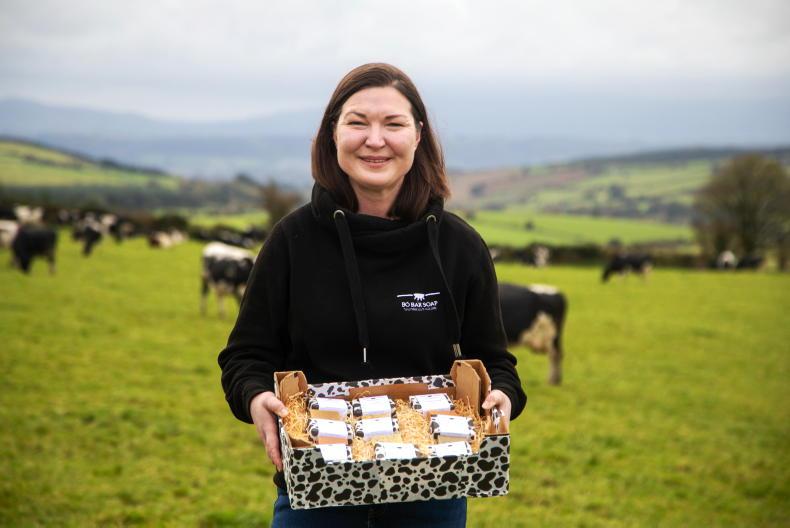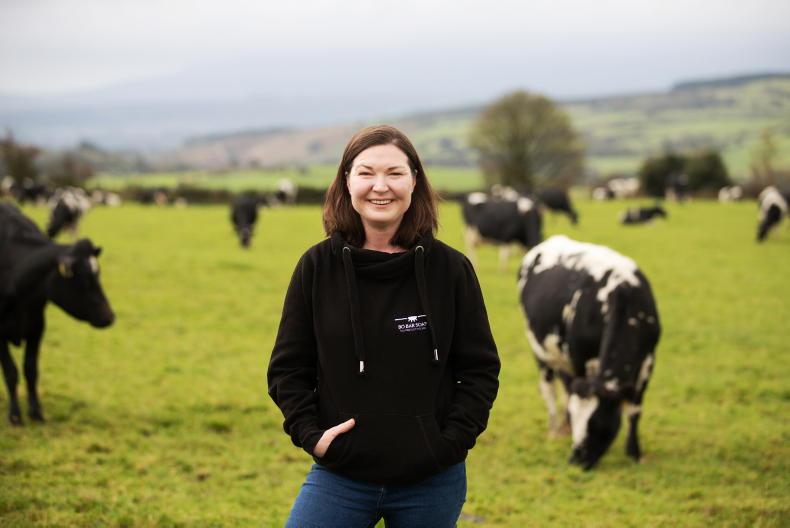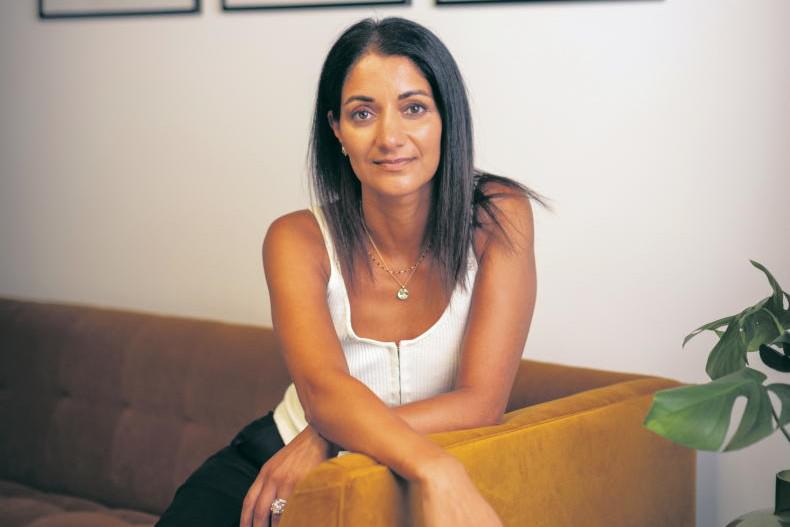We all know the nutritional benefits of drinking cow’s milk for our bodies. Loaded with vitamins A and D, it is also good for our skin, from the inside out. However, have you ever thought about the benefits of using it on your skin?
The benefits of a long hot soak in a milk bath is something that has been appreciated for centuries. We’ve all heard about how Cleopatra bathed in milk to achieve her perfect complexion and it was commonplace amongst ancient Romans to help improve the appearance of their skin.
Gail Daniels knows exactly about the benefits of cow’s milk for our skin. She is the founder and creator of Bó Bar Soap, a range of soaps made from dairy cows milk.
The milk doesnt have to travel far as Gail is married to Bryan Daniels. A ninth -generation dairy farmer, he is also a former recipient of a Nuffield Scholarship. Their farm is located in Kilmoganny, Co. Kilkenny and they are milking 275 cows.

Bó Bar soap made by Gail Daniels a dairy farmer based in Kilkenny who uses milk to create her products. \ Claire Nash
Surprisingly, it wasn’t the milk that inspired the business. Gail started the journey because her daughter, who was two years old at the time, had developed eczema and she didn’t want to use any products with chemicals on her skin.
Family business
“If you go to the doctor, you’ll get steroid cream, or in the chemist you can get liquid paraffin, but it’s all chemicals. I was looking for a natural solution,” explains Gail.
“I read up on alternatives and I heard about the benefits of goats milk soap. I got some, but it was from an Australian brand. I just thought to myself, why am I buying a bar soap from Australia? I checked and at that time, there was no Irish product like this.
“The idea for a milk product popped into my head then but I wondered why there was goat milk soap and not cow’s? I did research and flitted around with a few ideas but when lockdown happened, that’s when it really got serious.
“We have three children Shannon (8), Toby (6) and Eli (4). They were very young at the time, Eli was just 8 months and I needed a little bit of headspace for myself. You know, the adult section of my brain that didn’t involve Mr Tumble or arts and crafts. I did an online course and started making soap. It just all sort of spiralled from there.”
There is a real personal touch to the business. From branding to the soap variations, they are inspired by the people in Gail’s life.
“When I was designing the soap variations, the pink clay was for my daughter because she wanted a pink soap and the calendula was also for her because she likes the smell of lemon. My kids harvest the nettles for me. I have to pay Shannon 20 cents to go and rotate the soap once a week. She has a right little enterprise going on,” Gail laughs.
It really is a family operation. “Bryan has been really supportive, he made my stand for the Ploughing. Anything I need, he helps with. He does some post runs too; we have heifers the other side of the post drop so he drops parcels off for me.”
Gail has no major ambitions to turn Bó Bar Soap into a large scale company. “In the beginning, I just said that I wanted to make soap from the milk and if nothing else, we’d have a lifetime supply of soap.”

Bó Bar soap made by Gail Daniels a dairy farmer based in Kilkenny who uses milk to create her products. \ Claire Nash
Tried and tested
The process of making the soaps is something Gail has perfected over time. Normal soaps are made with water and, of course, there are different elements added depending on what you’re trying to achieve. You can add scents and some companies add colourings, preservatives, and all sorts of additives and chemicals. For Gail, the latter wasn’t an option.
The whole purpose was to keep it as natural as possible and that meant a clean ingredients list. All of Bó Bar Soaps are free from palm oil, parabens, chemicals, synthetic colours and all the added scents are 100% essential oils.
“I don’t use any water in my soap at all, I use a full milk replacement,” states Gail. If you Google it, you’ll see that people say – and it’s really just hyped up – that it’s really difficult to make it out of milk. But actually, when you properly research the way to do it, it’s not that difficult.”
Gail uses the traditional cold process method to handmake her soaps. This requires the soap bars to be cured for at least four weeks, but generally 5-6 weeks. As the products are genuinely handmade in small batches, each soap is unique in its size, colour, pattern and appearance, so they will vary slightly. The bars weigh a minimum of 95g but can range between 95 and 115g. She has formulated her soap recipe so that the bars are long lasting, but as Gail says, you can help with this yourself by not letting the bars sit in water, preferably keep them on a soap dish or soap saver so the bars can dry out between uses.
“When I first started making it, I gave some to my brother-in-law as a sort of tester, and he came back with, ‘Oh yeah, it’s all right, but it doesn’t last very long’. I had to go back and reformulate. It’s a lengthy process – you have to make it, then it needs to cure for six weeks, and then you need to test it in all different formats. It takes time but its worth it. What I use to make it long-lasting is tallow, which is basically beef drippings.
“Traditionally, soap would have been made with tallow, but as everything has progressed it has become more chemical-based. Other ingredients I use are coconut oil, castor oil, olive oil and different essential oils and each bar would have different things added or infused in it to give it its unique variation.”
Soap varieties
There are nine different variations of Bó Bar Soaps: plain & unscented, black & white, honey & oats, calendula, lavender, nettle, pink clay, gardener and mechanic. Each one is very individual and some have specific properties.
Calendula, for example, is made from petals; if you have redness or puffiness on your skin, it is good for bringing this down. The nettle one is anti-inflammatory. Where possible, Gail tries to use local ingredients, for example, for the honey & oats bar, she uses her uncle’s honey, who lives down the hill from her.
“I’m happy with the nine for now. There is potentially a new project in the works, in collaboration with a group. Each one has its own story, which I love.”
Read more
Women & Agriculture: a life in harmony
Swimming to Success
We all know the nutritional benefits of drinking cow’s milk for our bodies. Loaded with vitamins A and D, it is also good for our skin, from the inside out. However, have you ever thought about the benefits of using it on your skin?
The benefits of a long hot soak in a milk bath is something that has been appreciated for centuries. We’ve all heard about how Cleopatra bathed in milk to achieve her perfect complexion and it was commonplace amongst ancient Romans to help improve the appearance of their skin.
Gail Daniels knows exactly about the benefits of cow’s milk for our skin. She is the founder and creator of Bó Bar Soap, a range of soaps made from dairy cows milk.
The milk doesnt have to travel far as Gail is married to Bryan Daniels. A ninth -generation dairy farmer, he is also a former recipient of a Nuffield Scholarship. Their farm is located in Kilmoganny, Co. Kilkenny and they are milking 275 cows.

Bó Bar soap made by Gail Daniels a dairy farmer based in Kilkenny who uses milk to create her products. \ Claire Nash
Surprisingly, it wasn’t the milk that inspired the business. Gail started the journey because her daughter, who was two years old at the time, had developed eczema and she didn’t want to use any products with chemicals on her skin.
Family business
“If you go to the doctor, you’ll get steroid cream, or in the chemist you can get liquid paraffin, but it’s all chemicals. I was looking for a natural solution,” explains Gail.
“I read up on alternatives and I heard about the benefits of goats milk soap. I got some, but it was from an Australian brand. I just thought to myself, why am I buying a bar soap from Australia? I checked and at that time, there was no Irish product like this.
“The idea for a milk product popped into my head then but I wondered why there was goat milk soap and not cow’s? I did research and flitted around with a few ideas but when lockdown happened, that’s when it really got serious.
“We have three children Shannon (8), Toby (6) and Eli (4). They were very young at the time, Eli was just 8 months and I needed a little bit of headspace for myself. You know, the adult section of my brain that didn’t involve Mr Tumble or arts and crafts. I did an online course and started making soap. It just all sort of spiralled from there.”
There is a real personal touch to the business. From branding to the soap variations, they are inspired by the people in Gail’s life.
“When I was designing the soap variations, the pink clay was for my daughter because she wanted a pink soap and the calendula was also for her because she likes the smell of lemon. My kids harvest the nettles for me. I have to pay Shannon 20 cents to go and rotate the soap once a week. She has a right little enterprise going on,” Gail laughs.
It really is a family operation. “Bryan has been really supportive, he made my stand for the Ploughing. Anything I need, he helps with. He does some post runs too; we have heifers the other side of the post drop so he drops parcels off for me.”
Gail has no major ambitions to turn Bó Bar Soap into a large scale company. “In the beginning, I just said that I wanted to make soap from the milk and if nothing else, we’d have a lifetime supply of soap.”

Bó Bar soap made by Gail Daniels a dairy farmer based in Kilkenny who uses milk to create her products. \ Claire Nash
Tried and tested
The process of making the soaps is something Gail has perfected over time. Normal soaps are made with water and, of course, there are different elements added depending on what you’re trying to achieve. You can add scents and some companies add colourings, preservatives, and all sorts of additives and chemicals. For Gail, the latter wasn’t an option.
The whole purpose was to keep it as natural as possible and that meant a clean ingredients list. All of Bó Bar Soaps are free from palm oil, parabens, chemicals, synthetic colours and all the added scents are 100% essential oils.
“I don’t use any water in my soap at all, I use a full milk replacement,” states Gail. If you Google it, you’ll see that people say – and it’s really just hyped up – that it’s really difficult to make it out of milk. But actually, when you properly research the way to do it, it’s not that difficult.”
Gail uses the traditional cold process method to handmake her soaps. This requires the soap bars to be cured for at least four weeks, but generally 5-6 weeks. As the products are genuinely handmade in small batches, each soap is unique in its size, colour, pattern and appearance, so they will vary slightly. The bars weigh a minimum of 95g but can range between 95 and 115g. She has formulated her soap recipe so that the bars are long lasting, but as Gail says, you can help with this yourself by not letting the bars sit in water, preferably keep them on a soap dish or soap saver so the bars can dry out between uses.
“When I first started making it, I gave some to my brother-in-law as a sort of tester, and he came back with, ‘Oh yeah, it’s all right, but it doesn’t last very long’. I had to go back and reformulate. It’s a lengthy process – you have to make it, then it needs to cure for six weeks, and then you need to test it in all different formats. It takes time but its worth it. What I use to make it long-lasting is tallow, which is basically beef drippings.
“Traditionally, soap would have been made with tallow, but as everything has progressed it has become more chemical-based. Other ingredients I use are coconut oil, castor oil, olive oil and different essential oils and each bar would have different things added or infused in it to give it its unique variation.”
Soap varieties
There are nine different variations of Bó Bar Soaps: plain & unscented, black & white, honey & oats, calendula, lavender, nettle, pink clay, gardener and mechanic. Each one is very individual and some have specific properties.
Calendula, for example, is made from petals; if you have redness or puffiness on your skin, it is good for bringing this down. The nettle one is anti-inflammatory. Where possible, Gail tries to use local ingredients, for example, for the honey & oats bar, she uses her uncle’s honey, who lives down the hill from her.
“I’m happy with the nine for now. There is potentially a new project in the works, in collaboration with a group. Each one has its own story, which I love.”
Read more
Women & Agriculture: a life in harmony
Swimming to Success











SHARING OPTIONS